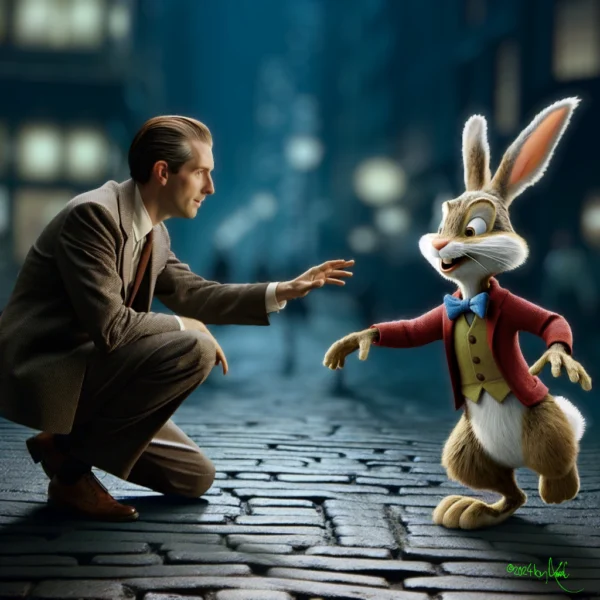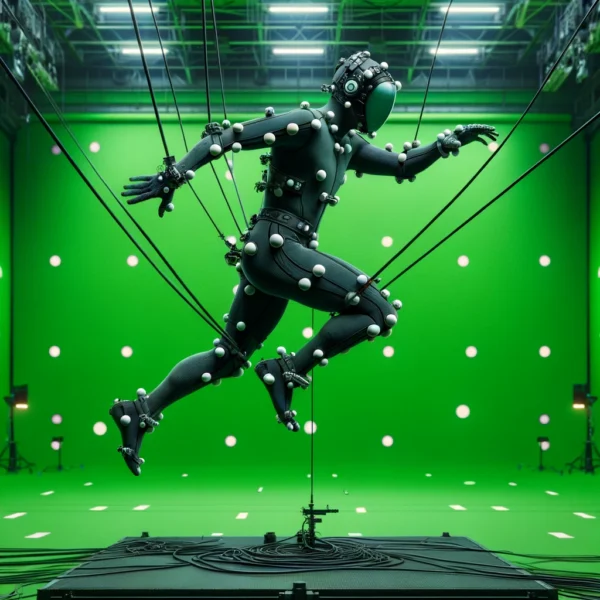
The birth of modern cinematography
The evolution of film technology, from hand-painted backdrops to the invention of digital compositing and node-based effects pipelines, marks a significant progression in cinematic history. The journey began with painted backgrounds in the early 1900s and has evolved into contemporary node-based digital workflows.
The Roundhay Garden Scene, filmed in October 1888 by Louis Le Prince with a single-lens camera of his own design, is widely regarded as the first movie in history. This finding has led to the reassessment of Thomas Edison’s role in the origins of cinematography, establishing Le Prince as the true pioneer.
Despite this historical revision, Thomas Edison’s contributions to film technology—marked by patents and a wealth of intellectual property—have played a pivotal role in advancing what we now recognize as the modern film camera. The field has witnessed numerous innovations that have shaped the development and application of film technologies, culminating in the dynamic industry we see today.
While we are not historians, we acknowledge and honor the contributions of those who have paved the way for the current state of the film industry, as well as those who will continue to advance it in ways we have yet to imagine.
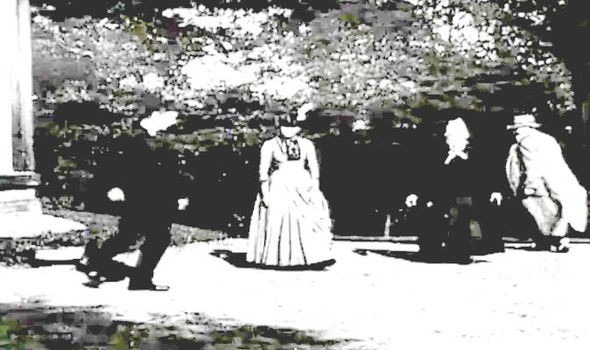
filmed in October 1888 by Louis Le Prince Source Creative Commons License Open Source
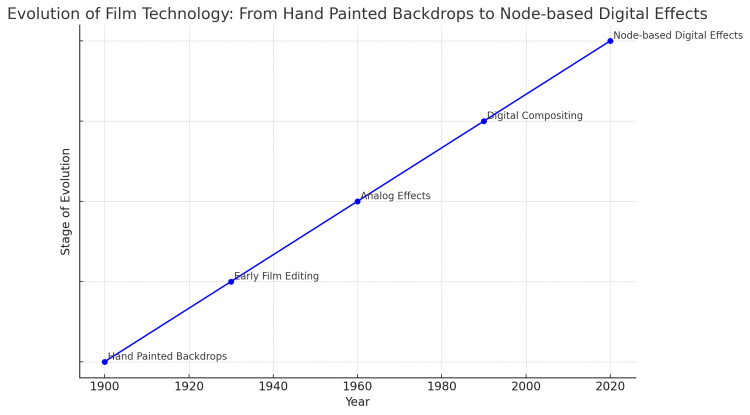
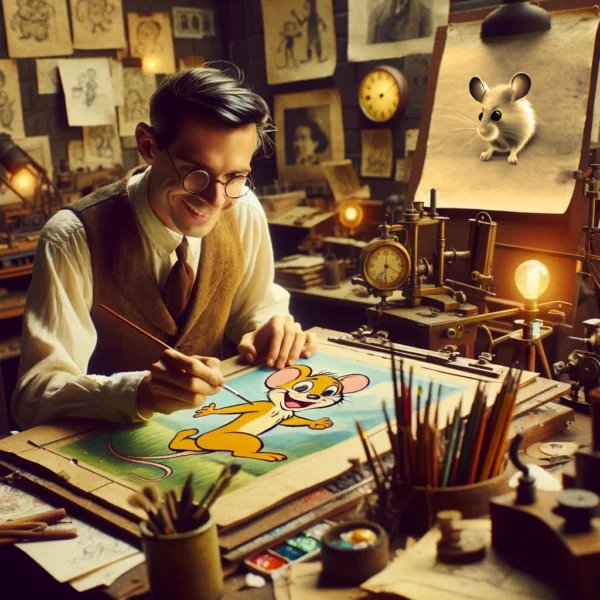
Hand painted cells in animation based cartoons
The evolution of animation techniques, particularly the use of hand-painted celluloid (cell) frames, represents a significant chapter in the history of technological advancements in animated storytelling.
When exploring the applications and impact of hand-painted cells within the context of animation technology, highlighting the transition from traditional to digital animation techniques. Traditional animation, characterized by the use of hand-painted celluloids, dominated the early 20th century, defining the aesthetic and production standards of the era. This technique involved creating individual frames on transparent sheets, which were then painted and projected sequentially to create the illusion of motion. Despite the advent of digital technologies, the principles established by traditional cell animation continue to influence contemporary animation practices.:
The process of creating hand-painted cells involves several stages: initial sketches, tracing onto celluloids, and painting the reverse side of these sheets. This ensures clarity and vibrancy in the final projection. The labor-intensive nature of this process necessitates a high degree of precision and artistic skill, contributing to the distinctive aesthetic qualities of traditional animation.
Applications and Impact. Hand-painted cells allowed for the integration of detailed background art and dynamic character movements, enhancing the narrative depth and visual appeal of animated works. Studios such as Disney, Warner Bros., and Fleischer Studios leveraged this technique to produce animations that have since become iconic. The organic variability inherent in hand-painted cells imbued animations with a unique charm, differentiating them from their digital counterparts.
A cornerstone of influence that eventually led to Digital Animation. The emergence of computer-generated imagery (CGI) and digital animation tools marked a shift in animation production techniques. Digital technologies offer greater efficiency and precision but lack the organic warmth of traditional cell animation. Contemporary animators often seek to replicate the aesthetic qualities of hand-painted cells through digital means, reflecting the enduring legacy of this traditional technique.
In Conclusion: Hand-painted cell animation represents a foundational element in the evolution of animation technologies. Despite the dominance of digital techniques, the principles derived from traditional cell animation continue to influence modern practices. This paper underscores the importance of hand-painted cells in the historical and technological development of animation, highlighting their continued relevance in the field.
References:
Crafton, D. (1993). Before Mickey: The Animated Film, 1898-1928. University of Chicago Press.
Solomon, C. (1989). Enchanted Drawings: The History of Animation. Alfred A. Knopf.
Thomas, F., & Johnston, O. (1981). Disney Animation: The Illusion of Life. Abbeville Press.
Merging animated cells with live motion film
The integration of hand-painted cells with live-action film represents a pivotal innovation in the convergence of animation and real-world cinematography. This paper examines the methodologies, technological advancements, and impact of merging traditional cell animation with live-action footage, highlighting its role in expanding the narrative and visual possibilities of film.
Introduction:
The marriage between hand painted and-painted animation and live-action filmmaking has opened new vistas for storytellers and visual artists. By overlaying animated characters and elements onto real-world scenes, filmmakers have been able to create fantastical universes that blend the imaginative flexibility of animation with the grounded realism of live-action cinema. This interdisciplinary approach has led to the creation of iconic cinematic works and has played a crucial role in the evolution of visual effects techniques.
Methodology:
The technique involves filming live-action scenes as a backdrop for animated characters, which are later integrated through the painstaking process of painting individual frames on transparent celluloid sheets. These animated cells are then composited over live-action footage, a method requiring precise alignment and timing to ensure seamless interaction between animated and real-world elements. The process demands not only artistic talent but also technological innovation in compositing and editing.
Technological Advancements:
The development of rotoscoping and other motion tracking technologies has facilitated the integration of hand-painted cells with live-action film. These tools allow animators to more accurately match the movements and interactions of animated characters with live actors and environments, enhancing the believability and dynamism of the combined footage. Additionally, advancements in camera and editing technologies have improved the efficiency and quality of compositing animated and live-action elements.
Its impact on the film industry – The merger of hand-painted cells and live-action footage has significantly influenced the film industry, enabling the creation of visually stunning and narratively complex works. Films that employ this technique often exhibit a distinctive aesthetic that captures the imagination of audiences, extending the storytelling capabilities of filmmakers. Furthermore, this interdisciplinary approach has paved the way for subsequent innovations in digital visual effects, CGI, and mixed media storytelling.
Iconic films such as Who Framed Roger Rabbit and Mary Poppins serve as seminal examples of the successful integration of hand-painted animation with live-action sequences. These works not only demonstrate the technical feasibility of merging these mediums but also explore the creative potential of such combinations, setting new standards for visual storytelling. The merger of hand-painted cells with live-action film has marked a significant milestone in the history of cinematic technology and artistry. This technique has not only expanded the visual and narrative toolkit available to filmmakers but also laid the groundwork for the development of contemporary visual effects and animation technologies. As such, the study of this merger is crucial for understanding the evolution of film as a medium for complex, interdisciplinary storytelling.
References:
Crafton, D. (1993). Before Mickey: The Animated Film, 1898-1928. University of Chicago Press.
Thomas, F., & Johnston, O. (1981). Disney Animation: The Illusion of Life. Abbeville Press.
Williams, R. (2001). The Animator’s Survival Kit. Faber and Faber.
Zimmerman, P. (2010). Reel Families: A Social History of Amateur Film. Indiana University Press.
Digital Film Compositing
As we continue to explore the move into digital film compositing, a process integral to contemporary filmmaking that involves the combination of visual elements from multiple sources into single images, creating the illusion of a unified scene. It examines the evolution, methodologies, and impact of digital compositing in the context of technological advancements in film production and visual effects.
Digital film compositing represents a significant leap forward in the art and science of film production, enabling filmmakers to weave together elements filmed separately into cohesive scenes. This technique has expanded the creative possibilities of cinema, allowing for the creation of complex visual narratives that were previously impossible or financially impractical.
This level of compositing involves several processes, including keying, tracking, and layering. Keying allows for the isolation of a single color or brightness value within an image, making it possible to remove backgrounds or insert characters into new environments. Tracking is used to match the movements of composited elements with the camera motions of the original footage, ensuring consistency across frames. Layering and blending integrate these elements, adjusting for light, shadow, and texture to create seamless scenes.
The development of software such as Adobe After Effects, Nuke, and Autodesk Flame has been pivotal in advancing digital compositing. These tools offer sophisticated features for manipulating images, enhancing the realism and dynamism of composited scenes. Innovations in computer processing power and graphics technology have further expanded the capabilities of digital compositing, enabling more complex and detailed compositions. Digital compositing has profoundly impacted the film industry, both aesthetically and economically. It has revolutionized visual storytelling, allowing for the creation of vivid, immersive worlds that draw audiences into the narrative. Economically, digital compositing has made it possible to achieve visual effects that would have been prohibitively expensive or logistically challenging with traditional methods, thereby broadening the scope of projects that can be undertaken.
Films such as Avatar, The Lord of the Rings, and Gravity showcase the potential of digital compositing to create detailed, immersive environments and to blend CGI with live-action footage seamlessly. These examples highlight the technique’s ability to enhance narrative depth and visual impact, setting new standards for cinematic experiences.
Digital film compositing is a cornerstone of modern filmmaking, representing a fusion of art and technology that has expanded the boundaries of visual storytelling. As software and hardware continue to evolve, the potential for innovative uses of digital compositing is boundless, promising to further transform the cinematic landscape.
References
Brinkmann, R. (2008). The Art and Science of Digital Compositing. Morgan Kaufmann.
Wright, S. (2010). Digital Compositing for Film and Video. Focal Press.
Kerlow, I. V. (2004). The Art of 3D Computer Animation and Effects. John Wiley & Sons.
Node-Based Digital Effects Composition – Revolutionizing Visual Storytelling in Cinematography.
In the rapidly evolving digital effects landscape, node-based composition emerges as a pivotal innovation, reshaping the creation of visual effects (VFX) in photography and film. This technique enables the intricate construction, modification, and combination of effects in a visual and intuitive manner, transforming post-production approaches and the tools used in the pipeline.
At the heart of Node-Based Composition are node-based composition involves the use of a graph-like dropdown where each node represents a different function or effect, such as color correction, blurring, or keying. These nodes are connected in a flowchart-like arrangement, creating a complex web of effects that are composited over footage to produce the desired outcome.
This methodology affords unparalleled control over the creative process, enabling artists to visualize and tweak every aspect of their composition in real-time. Node-based visual effects pipelines significantly enhances creative potential by facilitating the consistent and precise reproduction of effects.
This is achieved by integrating vast libraries of procedural elements with sophisticated compositing techniques across digital imaging timelines. Such pipelines support a highly flexible workflow, enabling artists to manipulate and adjust individual nodes—each representing a distinct visual effect or process—without affecting the overall project. This approach not only enhances efficiency but also encourages experimentation, allowing for the dynamic alteration of visual elements and effects in real-time, ensuring a seamless blend of visuals within complex scenes.
This approach facilitates consistent application and modification of visual effects, ensuring seamless integration within complex scenes. The primary allure of node-based composition lies in its flexibility and non-destructive nature. Unlike layer-based systems, where effects are stacked linearly, node-based workflows allow for a more dynamic interaction between effects. This not only fosters a more experimental approach to image manipulation but also significantly enhances the efficiency of the editing process. Photographers can easily adjust parameters within any node without disrupting the overall composition, encouraging a trial-and-error method that leads to innovative outcomes.
At the heart of Node-Based Composition are node-based composition involves the use of a graph-like dropdown where each node represents a different function or effect, such as color correction, blurring, or keying. These nodes are connected in a flowchart-like arrangement, creating a complex web of effects that process the input image or footage to produce the desired outcome. This methodology affords unparalleled control over the creative process, enabling artists to visualize and tweak every aspect of their composition in real-time.
Node-based visual effects pipelines significantly enhances creative potential by facilitating the consistent and precise reproduction of effects.
This is achieved by integrating vast libraries of procedural elements with sophisticated compositing techniques across digital imaging timelines. Such pipelines support a highly flexible workflow, enabling artists to manipulate and adjust individual nodes—each representing a distinct visual effect or process—without affecting the overall project. This approach not only enhances efficiency but also encourages experimentation, allowing for the dynamic alteration of visual elements and effects in real-time, ensuring a seamless blend of visuals within complex scenes.
This approach facilitates consistent application and modification of visual effects, ensuring seamless integration within complex scenes. The primary allure of node-based composition lies in its flexibility and non-destructive nature.
Unlike layer-based systems, where effects are stacked linearly, node-based workflows allow for a more dynamic interaction between effects. This not only fosters a more experimental approach to image manipulation but also significantly enhances the efficiency of the editing process. Photographers can easily adjust parameters within any node without disrupting the overall composition, encouraging a trial-and-error method that leads to innovative outcomes.
Revolutionizing Post-Production – In the context of modern photography and cinematography, node-based digital effects composition is revolutionizing post-production workflows. It is particularly valuable in complex compositing tasks, where elements from different sources must be seamlessly integrated into a single image. Moreover, the ability to reuse and modify node structures has streamlined the workflow for VFX artists, saving time and resources while maintaining high levels of creativity and precision.
Challenges and Considerations – Despite its advantages, the transition to node-based composition can present challenges, particularly for those accustomed to traditional layer-based systems. The initial learning curve can be steep, requiring a deep understanding of how different nodes interact and affect the final image. However, many find that the effort to master this system pays off in the increased flexibility and control over their creative output.
Node-based composition has become integral to visual effects (VFX) and film editing, with several leading software programs standing out for their powerful capabilities and widespread industry adoption. These tools are favored for their flexibility, precision, and comprehensive toolsets that cater to the demanding needs of professionals in film production and post-production.
Here are some of the top software programs utilizing node-based composition:
Nuke by Foundry
Nuke is a powerhouse in the VFX industry, renowned for its advanced node-based compositing, 3D modeling, and motion graphics capabilities. It’s widely used in the film and television industry for complex compositing tasks, offering a high degree of control and flexibility. Its comprehensive toolset and robust performance make it a standard choice among VFX professionals.
Autodesk Flame
Autodesk Flame® software is a powerful finishing and visual effects solution with an integrated environment that accelerates creative workflows.
Deliver commercials, TV episodes, and films with AI-powered, pixel-perfect visual effects
Enhance every project with a robust, integrated color grading and finishing toolset
Build complex 3D scenes with an intuitive, node-based compositing system
Fusion by Blackmagic Design
Fusion, part of Blackmagic Design’s DaVinci Resolve, is a formidable competitor in the node-based composition arena. It offers a wide range of VFX tools within a node-based interface, including 3D compositing, keying, painting, and particle effects. Fusion is integrated into DaVinci Resolve, making it an attractive option for a seamless editing and post-production workflow.
Houdini by SideFX
While Houdini is best known for its prowess in procedural 3D animation and effects, it also features a powerful node-based workflow for composition and VFX. Houdini’s node-based procedural approach is particularly beneficial for creating complex simulations and effects, such as fluids, fire, and destruction in film production. Houdini is a 3D animation software application developed by Toronto-based SideFX, who adapted it from the PRISMS suite of procedural generation software tools. The procedural tools are used to produce different effects such as complex reflections, animations and particles system.
Blender
Blender is a free, open-source 3D creation suite that includes support for node-based composition through its compositing and material nodes. It offers a broad range of features, including modeling, animation, simulation, rendering, and video editing. Blender’s node-based system is versatile, catering to both 3D and 2D composition needs.
Adobe After Effects with third-party plugins
While Adobe After Effects is primarily layer-based, its functionality can be extended to support a node-based workflow through third-party plugins like Red Giant’s Universe or Boris FX’s Sapphire. These additions enrich After Effects with node-based compositing features, blending the software’s intuitive interface with the power of node-based logic.
The Future of Visual Effects
As technology advances, node-based composition is set to play an increasingly central role in the future of visual effects. Its adaptability and efficiency make it well-suited to the demands of high-resolution photography and ultra-high-definition video production. Furthermore, with the integration of AI and machine learning algorithms into node-based systems, we are on the cusp of a new era of automated and intelligent effects processing that could further revolutionize the field. Node-based digital effects composition represents a significant leap forward in the art and science of digital imagery. By offering an unprecedented level of control and flexibility, it empowers photographers and filmmakers to push the boundaries of visual storytelling. As we continue to explore the possibilities of this innovative approach, it is clear that the future of photography and film will be increasingly shaped by the creative potential of node-based composition.

